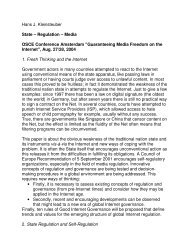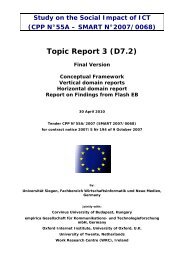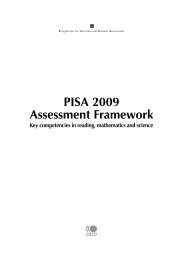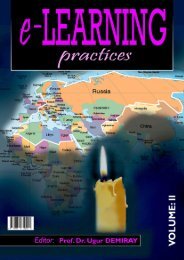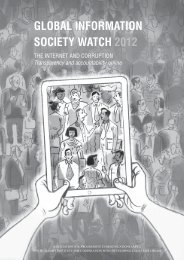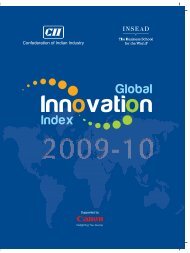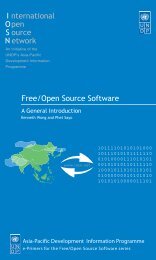Annex A. Localization – Key Concepts ❘ 25Standard Code for Information Interchange), in which up to 128 characters can be represented, which isjust sufficient for English. However, when the need to use non-English languages in computers arose,other encodings were defined. The concept of codepages was devised as enhancements to ASCII byadding characters as the second 7-bit half, making an 8-bit code table in total. Several codepages weredefined by vendors for special characters for decoration purpose and for Latin accents. Some non-European languages were added by this strategy, such as Hebrew and Thai. National standards weredefined for character encoding.The traditional encoding systems were not suitable for Asian languages that have large character setsand particular complexities. For example, the encoding of Han characters used by the Chinese, Japaneseand Korean (CJK), the total number of which are still not determined, is much more complicated. A largenumber of codepages must be defined to cover all of them. Moreover, compatibility with other singlebyteencodings is another significant challenge. This ends up in some multi-byte encodings for CJK.However, having a lot of encoding standards to support is a problem for software developers. A group ofvendors thus agreed to work together to define a single character set that covers the characters of alllanguages of the world, so that developers have a single point of reference, and users have a singleencoding. The Unicode Consortium was thus founded. Major languages in the world were added to thecode table. Later on, ISO and IEC formed JTC1/SC2/WG2 to standardize the code table, which is publishedas ISO/IEC 10646. Unicode is also a member of the working group, along with standard bodies of ISOmember countries. Both Unicode and ISO/IEC 10646 are synchronized, so the code tables are the same.But Unicode also provides additional implementation guidelines, such as character properties, rendering,editing, string collation, etc.Nowadays, many applications have moved to Unicode and have benefited from the clear definitions forsupporting new languages. Users of Unicode are able to exchange information in their own languages,especially through the Internet, without compatibility issues.FontsOnce the character set and encoding of a script are defined, the first step to enabling it on a system is todisplay it. Rendering text on the screen requires some resource to describe the shapes of the characters,i.e., the fonts, and some process to render the character images as per script conventions. The process iscalled the output method. This section will try to cover important aspects of these requirements.Characters and GlyphsA font is a set of glyphs for a character set. A glyph is an appearance form of a character or a sequence ofcharacters. It is quite important to distinguish the concepts of characters and glyphs. For some scripts, acharacter can have more than one variation, depending on the context. In that case, the font may containmore than one glyph for each of those characters, so that the text renderer can dynamically pick theappropriate one. On the other hand, the concept of ligatures, such as “ff” in English text, also allows somesequence of characters to be drawn together. This introduces another kind of mapping of multiplecharacters to a single glyph.Bitmap and Vector FontsIn principle, there are two methods of describing glyphs in fonts: bitmaps and vectors. Bitmap fontsdescribe glyph shapes by plotting the pixels directly onto a two-dimensional grid of determined size,while vector fonts describe the outlines of the glyphs with line and curve drawing instructions. In otherwords, bitmap fonts are designed for a particular size, while vector fonts are designed for all sizes. Thequality of the glyphs rendered from bit-map fonts always drops when they are scaled up, while that fromvector fonts does not. However, vector fonts often render poorly in small sizes in low-resolution devices,such as computer screens, due to the limited pixels available to fit the curves. In this case, bitmap fontsmay be more precise.Nevertheless, the quality problem at low resolution has been addressed by font technology. For example:Hinting, additional guideline information stored in the fonts for rasterizers to fit the curves ina way that preserves the proper glyph shape.
26 ❘ FREE/OPEN SOURCE SOFTWARE: LOCALIZATIONAnti-aliasing, capability of the rasterizer to simulate unfitted pixels with some illusion to humanperception, such as using grayscales and coloured-subpixels, resulting in the feeling of “smoothcurves.”These can improve the quality of vector fonts at small sizes. Moreover, the need for bitmap fonts inmodern desktops is gradually diminishing.Font FormatsCurrently, the X Window system for GNU/Linux desktop supports many font formats.BDF FontsBDF (Bit-map Distribution Format) is a bitmap font format of the X Consortium for exchanging fonts in aform that is both human-readable and machine-readable. Its content is actually in plain text.PCF FontsPCF (Portable Compiled Format) is just the compiled form of the BDF format. It is binary and thus, onlymachine-readable. The utility that compiles BDF into PCF is bdftopcf. Although BDF fonts can be directlyinstalled into the X Window system, they are usually compiled for better performance.Type 1 FontsType 1 is a vector font standard devised by Adobe and supported by its Postscript standard. So it is wellsupported under most UNIX and GNU/Linux, through the X Window system and Ghostscript. Therefore,it is the recommended format for traditional UNIX printing.TrueType FontsTrueType is a vector font standard developed by Apple, and is also used in Microsoft Windows. Its popularityhas grown along with the growth of Windows. XFree86 also supports TrueType fonts with the help of theFreeType library. Ghostscript has also supported TrueType. Thus, it becomes another potential choice forfonts on GNU/Linux desktops.OpenType FontsRecently, Adobe and Microsoft have agreed to create a new font standard that covers both Type 1 andTrueType technologies with some enhancements to cover the requirements of different scripts in theworld. The result is OpenType.An OpenType font can describe glyph outlines with either Type 1 or TrueType splines. In addition,information for relative glyph positioning (namely, GPOS table) has been added for combining marks tobase characters or to other marks, as well as some glyph substitution rules (namely, GSUB table), so thatit is flexible enough to draw characters of various languages.Output MethodsOutput method is a procedure for drawing texts on output devices. It converts text strings into sequencesof properly positioned glyphs of the given fonts. For the simple cases like English, the character-toglyphmapping may be straightforward. But for other scripts the output methods are more complicated.Some could be with combining marks, some written in directions other than left-to-right, some withglyph variations of a single character, some requiring character reordering, and so on.With traditional font technologies, the information for handling complex scripts is not stored in thefonts. So the output methods bear the burden. But with OpenType fonts, where all of the rules are stored,the output methods just need the capability to read and apply the rules.Output methods are defined at different implementations. For X Window, it is called X Output Method(XOM). For GTK+, it uses a separate module called Pango. For Qt, it implements the output method bysome classes. Modern rendering engines are now capable of using OpenType fonts. So, there are twoways of drawing texts in output method implementations. If you are using TrueType or Type 1 fonts andyour script has some complications over Latin-based languages, you need to provide an output methodthat knows how to process and typeset characters of your script. Otherwise, you may use OpenTypefonts with OpenType tables that describe rules for glyph substitution and positioning.



